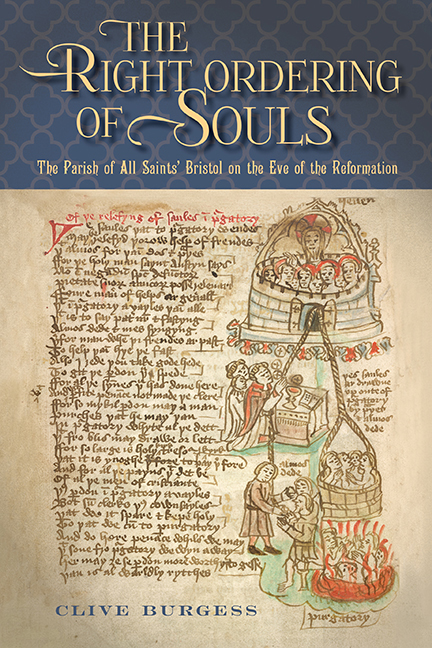Book contents
- Frontmatter
- Dedication
- Contents
- List of illustrations
- Acknowledgements
- Miscellaneous Frontmatter
- Abbreviations
- Notes
- map
- Part I For the increase of the divine service
- Part II All Saints’, Bristol, and its parishioners
- Part III Commemorating the dead
- Part IV Leaders and administrators
- Part V Ordering the parish
- 10 ‘Was but single and no thing of beauty’: Enhancing the parish church
- 11 ‘To the laud and the loving of Almighty God’: Increasing divine service in All Saints’
- Conclusion ‘What else, I ask you, is a city than a great monastery?’
- Appendices
- Bibliography
- Glossary
- Index
- Miscellaneous Endmatter
10 - ‘Was but single and no thing of beauty’: Enhancing the parish church
from Part V - Ordering the parish
Published online by Cambridge University Press: 05 May 2018
- Frontmatter
- Dedication
- Contents
- List of illustrations
- Acknowledgements
- Miscellaneous Frontmatter
- Abbreviations
- Notes
- map
- Part I For the increase of the divine service
- Part II All Saints’, Bristol, and its parishioners
- Part III Commemorating the dead
- Part IV Leaders and administrators
- Part V Ordering the parish
- 10 ‘Was but single and no thing of beauty’: Enhancing the parish church
- 11 ‘To the laud and the loving of Almighty God’: Increasing divine service in All Saints’
- Conclusion ‘What else, I ask you, is a city than a great monastery?’
- Appendices
- Bibliography
- Glossary
- Index
- Miscellaneous Endmatter
Summary
Its location at the centre of the town meant that All Saints’ church was – and remains – cramped: hemmed in by other buildings, only the tower and north aisle are visible from a major thoroughfare. The body of the church measures no great length, possessing a nave of only five bays; given that the church has two aisles, its interior (disregarding the chancel momentarily) is not so far from being as broad as it is long. As a result, the church housed four side-altars arranged ‘across’ the church at the east end of its aisles and nave, all in addition to its high altar in the chancel. By the mid fifteenth century, the side-altars were dedicated to the Blessed Virgin Mary in the north (or Lady) aisle and to the Holy Rood in the south aisle (the latter being commonly referred to as the Rood altar in the Cross aisle); those on either side of the chancel arch and in front of the rood screen were dedicated to St Thomas on the north side, and to Sts John the Baptist, John the Evangelist and Dunstan on the south.
The church housed the Kalendars’ guild, a long-established fraternity which, by the later fifteenth century, served both the secular clergy and the laity of the town, and supported a prior and two priests. Their house jutted into the north aisle of All Saints’ church at first-floor level at the west end of the church, and here they kept the library stocked by Bishop Carpenter. Given that, from the 1430s, the parish incumbent resided in a house that similarly jutted into the south aisle of the church and, also, that the Halleways’ chantry priest had a chamber adjacent to the parish cemetery on the south side of the church, the presence of five full-time clergy effectively living and working in the parish church might, at first glance, seem to have been out of all proportion, both with the communicant population of the parish (numbering approximately 180) and also the small dimensions of the church itself.
- Type
- Chapter
- Information
- 'The Right Ordering of Souls'The Parish of All Saints’ Bristol on the Eve of the Reformation, pp. 331 - 382Publisher: Boydell & BrewerPrint publication year: 2018

